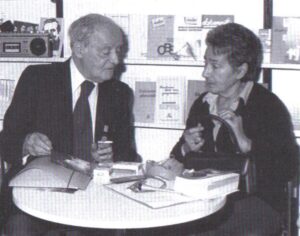What do the Poles look like nowadays?
– Like potatoes: some in uniform, some mashed.

Zofia Hertz and Jerzy Giedroyc – October 1982, International Book Fair, Frankfurt am Main (photo: The Literary Institute Archive). Public Domain
These types of sarcastic jokes were published in the ‘Culture’ under the heading ‘National Humour’, edited since the late 1960s by Zofia Hertz (née Neuding). She was born in 1910 in Warsaw in the jewish family. She studied at the Faculty of Law of the University of Warsaw. After a year, she returned to Łódź again, and despite financial problems, but mainly as a result of her hard work, on May 13, 1933, she was the first woman in Poland to pass a notary exam. However, due to existing legal obstacles, she never practiced this profession. In Łódź, she worked as a clerk, and there she married Zygmunt Hertz, the son of a chemical entrepreneur. During the September 1939 campaign, Zygmunt fought in the anti-aircraft defense of Warsaw. Then they both found themselves in Lviv, where in June 1940 they were arrested and deported. They were sent to the Mari Soviet Socialist Republic, where in a colony settlement Cynglok they worked for 14 months felling trees. In 1941, they were released under the Sikorski-Majski agreement and reached the newly formed Anders’ Army.
Initially, Zofia worked at the Army Staff in Buzuluk in the editorial office of the ‘White Eagle’ – the magazine published by The Military Office of Propaganda and Education of the Polish Armed Forces in the USSR, the editors of which were Jerzy Giedroyc and Gustaw Herling-Grudziński. Then in Cairo she joined the editorial board of the illustrated magazine ‘Parade’, and in 1943, during the stoppage of Polish troops in the Quizil Ribat desert in Iraq, she established closer cooperation with Jerzy Giedroyc. After reaching Italy, she worked as a typist in the editorial office of ‘The Journal of the Soldier of the Polish Army in the East’.
In 1946, in Rome, she co-created the Literary Institute and ran the secretariat of this publishing house. After moving the Institute to Maisons-Laffitte in France, together with her husband, Jerzy Giedroyc, Józef Czapski and his sister Maria, they created a ‘Polish home’ in France. Working at the Literary Institute, she was involved in translations, editing and proofreading. In ‘Culture’ she edited the ‘National Humour’ column. On account of her work at the Institute, in 1948 she obtained the political refugee status. She never applied for French citizenship. In 2000 she was awarded The Order of the Rebirth of Poland. She was also the laureate of many national and foreign awards. Zofia Hertz died on 20 June 2003 in Maisons-Laffitte. She rested next to her husband and other creators of the Parisian ‘Culture’ at the cemetery in Mesnil-le Roi.
Translated from Polish: Sylwia Szarejko, Kamila Czechowska
Biogram based on the book: S. Szarejko, Kobiety niepokonane/Undefeated Woman, Białystok 2019, edited by Sybir Memorial Museum



